Rank Math is jam-packed with on-page SEO tools, and in this article, we’re going to show you How To Use Rank Math Meta Box To Optimize Content: to write, edit, and optimize your posts for search engines, users, and social media.
On-page SEO is a sadly neglected field – most people focus only on off-page factors. That is an opportunity in disguise for you as you can beat your competition by being good at off-page and on-page SEO.
Also, while in off-page SEO you have to build a lot of links and depend on others for your website’s benefit, in on-page SEO, all the optimizations are under your control.
You’d think that on-page SEO would be more popular, but because it is complicated, takes some time, and makes you deal with code, most people choose the easy route and ignore it altogether.
That is why we built Rank Math, and it’s Meta Box, which helps optimize any post in just a few clicks. That is what we are going to introduce to you today.
By the end of this guide, you’ll know how to use each of the tools in the meta-box to nail your on-page SEO and improve your social media results along the way.
What and Where is the Meta Box
The first step in optimizing your post is to find the Meta Box. To make the process of optimizing your content and posts, we’ve added the Meta Box on the same page where you write your content—in the post editing screen. All you have to do is scroll a tiny bit below the text area, and you’ll see it. Here is how it looks if you’re using the block editor.
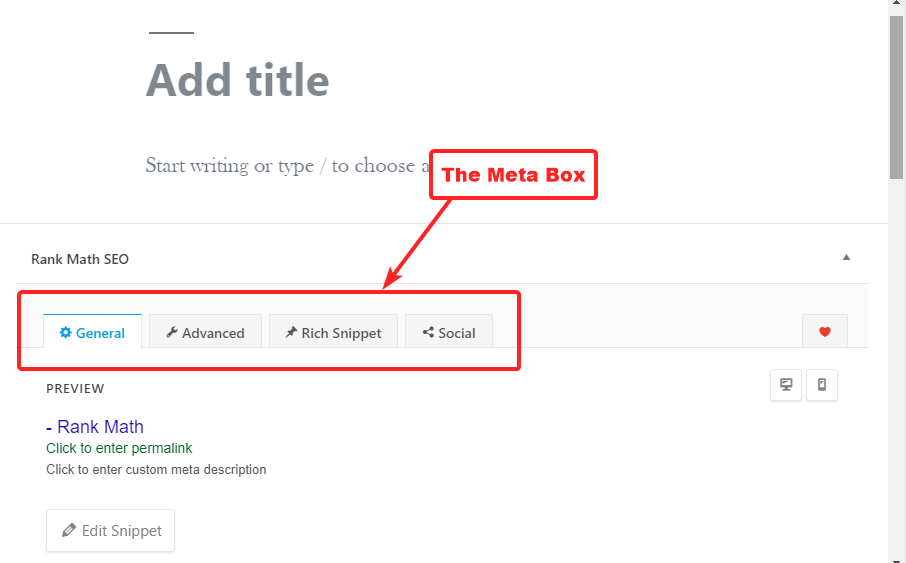
Things are similar on the block editor as well, and you’ll find the meta box just below the text area there too.
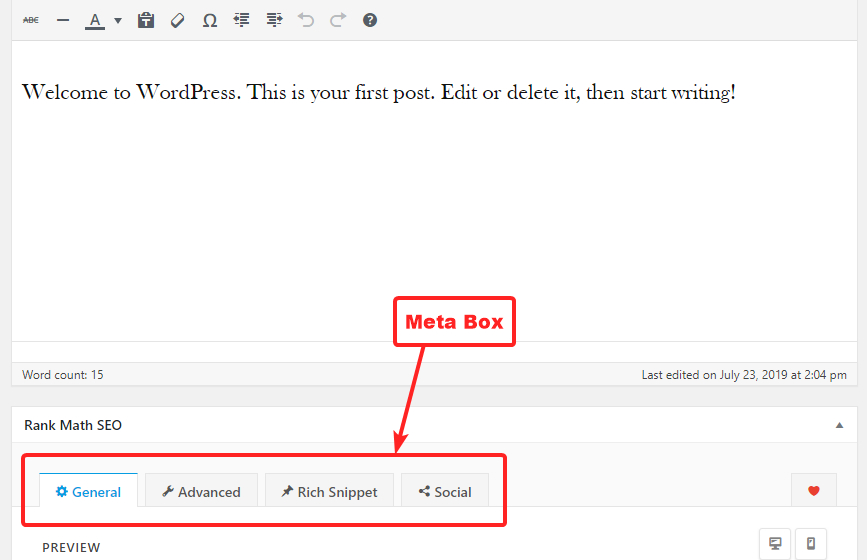
Rank Math isn’t just one tool. It’s more like a “Swiss Army Knife” – dozens of specific tools bundled together into a single package. With so many tools, the interface could easily become confusing. So we’ve broken the panel down into 4 tabs. No prizes for guessing what each of those tabs do, as their names are self-explanatory. Let us give you an overview of each of the tabs. You can click on the heading of each of the tab to go to a dedicated article about all the settings the tab contains.
Before You Explore the Sections and their Settings
The Meta Box is a powerhouse. It has tons of options and settings to configure and configuring them right will definitely improve your search engine and social presence. But, you might be overwhelmed with the sheer number of options present in the meta box.
Before that happens, we should clarify that you will not need to configure all the options in the meta box for all your posts. Specifically, you will configure all the settings for all your posts, but you won’t have to configure each setting for every single post.
The Meta Box inherits its settings from the default settings that you configure in Rank Math’s settings. When you configure the General Settings, the Title and Meta settings, and other settings, you are creating a default set of settings that will be imported for each post. That means that for most posts, you won’t even have to change a setting, and you can hit publish instantly. For the posts that do need custom settings, you will just have to change the settings that are different for that post, the rest of the setting will remain the same.
The Tabs in the Meta Box
As we mentioned, the Rank Math meta-box has 4 tabs. Here they are:
- General Tab
- Advanced Tab
- Rich Snippet
- Social
Here is what each of the tabs does:
1 – General Tab
The General Tab is dedicated to on-page SEO. It helps you optimize your content, your images, URLs, and other factors. Apart from that, you can also optimize your SEO title, URL, and your meta description from the meta box and get a real-time preview of how your website’s result will appear to others in the search results—it is a pretty nifty feature to improve your click-through rate and beat your competition.
The process of optimization of your post’s content is actually pretty simple. All you have to do is add a bunch of focus keywords to your post, and Rank Math will instantly analyze your post and give you specific recommendations that you can use to optimize your post. Here are all the options that you will find in the General Tab of the Rank Math Meta Box.
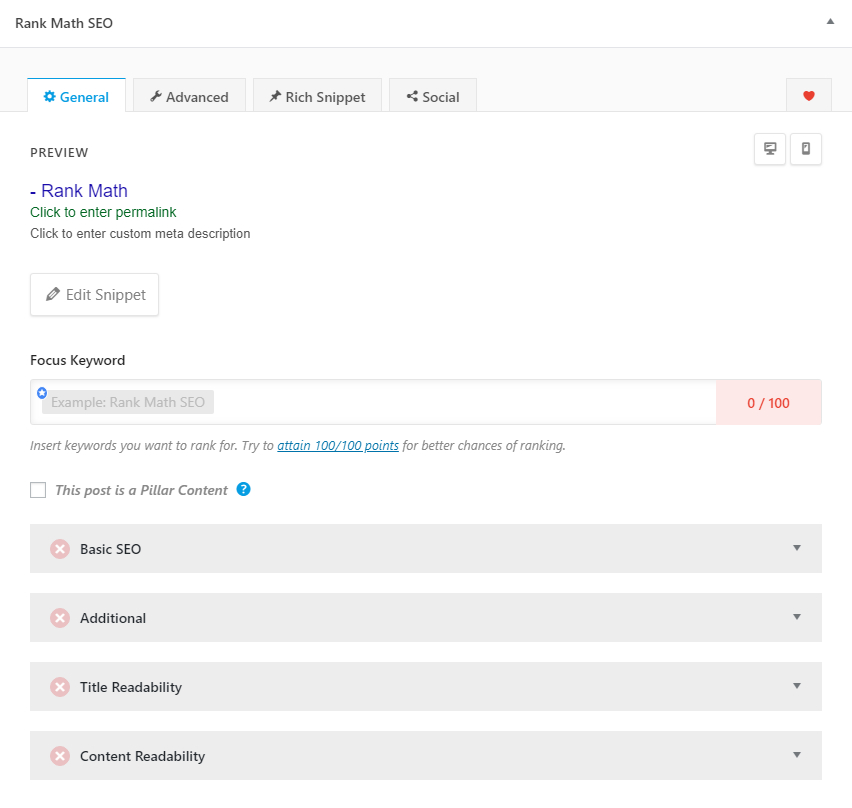
Click here to go to a detailed tutorial about the General Tab.
2 – The Advanced Tab
The Advanced Tab is where all the Advanced Settings are. These settings also affect your post’s optimization, but not in the same way the General Settings do. To be more specific, the General Tab analyzes the content and tells you to perform the recommendations, but the settings in the Advanced Tab affect how search engines behave once they find your content.
Here you can specify your robots meta, your canonical URL, and some other settings that affect your post. Here are all teh settings that you should see in this tab.
- Rank Math FAQ [21 Solid Frequently Asked Questions And Answers By Rank Math]
- Rank Math General Settings In 3 Easy Steps
- Rank Math Import And Export Settings In 5 Easy Steps
- Rank Math Sitemap Issues and Their Fixes
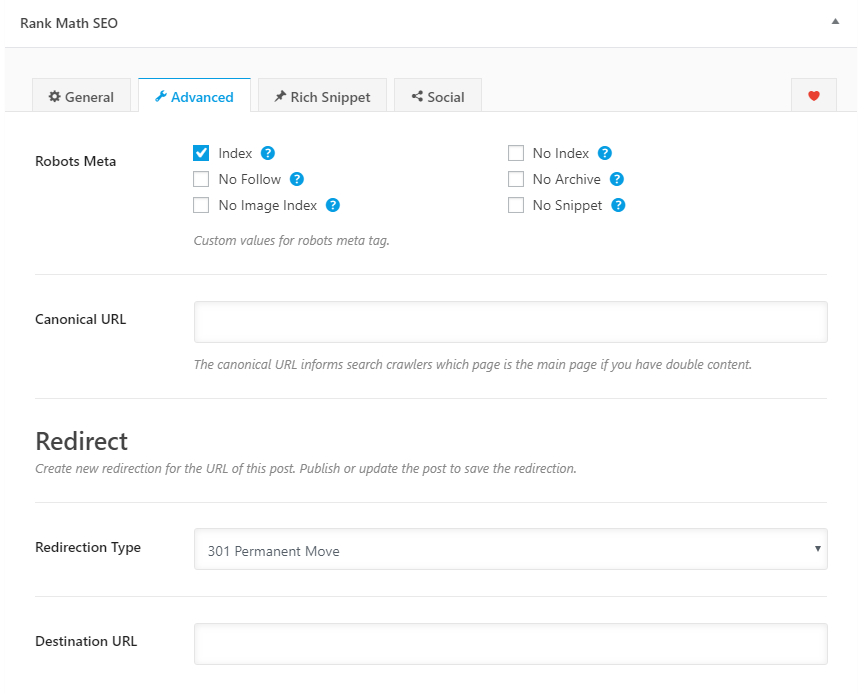
Click here to go to the dedicated tutorial on configuring the settings in the Advanced Tab.
3 – Rich Snippets
If you pay attention to Google’s results, then you’ll notice that they are shifting more towards rich results. What do we mean by rich results, you may ask.
Rich results mean that Google just does not display 10 results on your screen, but they try to give you more information with every query you ask. Not only that, Google tries to interpret your query, or estimate the context of your query before it shows you a result.
We’re sure that you’re aware of star ratings that appear in the search results. They were the earliest form of rich results. But now you have star ratings, knowledge graph, maps, Google My Business listings, sitelinks, jump to links, video results, video results with duration highlighted, answer meta box, FAQs, people usually ask suggestions, and many more. All of these are rich results.
The dominance of rich results creates an impression that Google is super-smart, and it can actually understand what pages are about. That is not completely true. Although Google does understand a lot about the web-pages it crawls, a majority of the information in the rich results is provided by the website owner.
How? Through meta-data. Meta-data literally translates to data about data. To put that in perspective, let us take an example.
If you had a recipe website and created a page about honey and lime roasted chicken, you’ll probably include the ingredients you’d use, the spices, the prep time, the cooking process, and a bunch of other stuff. When Google visits your page, it will have to figure all these things out to create a rich result.
But what if you just told them? Instead of Google trying to figure it out, Google, and you can save a bunch of time and resources in crawling and interpreting data if the meta-data is available.
This is what the rich snippets section is about. It helps you add all sorts of juicy metadata to your page about articles, recipes, reviews, books, job offers, restaurants, software, and more. When your website provides all this rich data to Google, its chances of appearing as a rich result become significantly higher. Here are all the options that you would see in the Rich Snippet option.
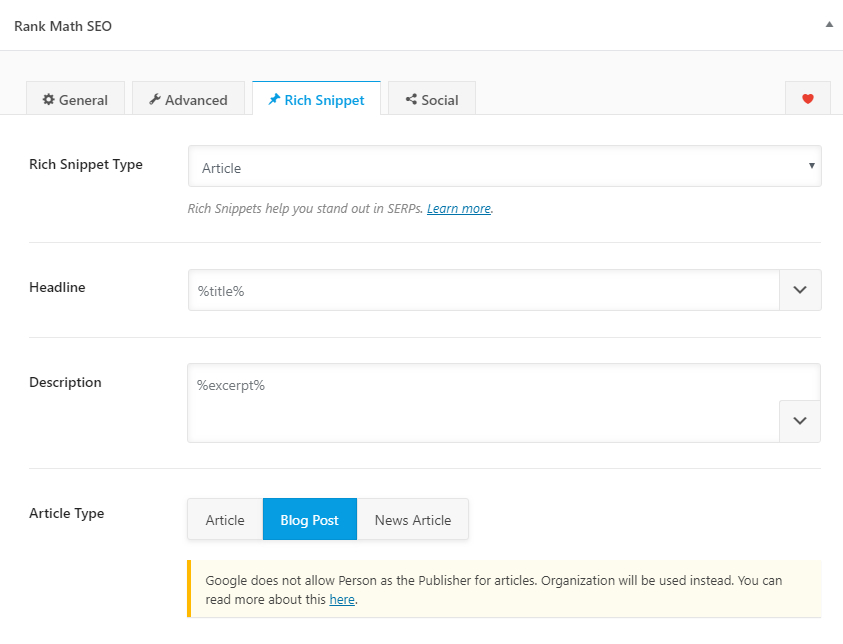
Click here to read the dedicated article about configuring Rich Snippets in Rank Math.
4 – Social Tab
Just as there isn’t one universal language spoken worldwide, there isn’t one language for website metadata. Many standards have been created and lost in the attempt of standardizing the language of the web. Currently, the most popular language for metadata is Schema, which remains a collaborative effort of Google, Microsoft, Pinterest, Yandex, and many others. While Schema is now universally accepted by the search engines, the rise of social media created the need for another micro-data format.
Social media platforms behave differently than search engines, and they need different data than search engines too. Keeping this in mind, Facebook introduced its own metadata format called Open Graph in 2010. Since then, it has become the standard metadata format across all social media.
The Social Tab helps you add open graph metadata to your posts in a visual way. Instead of diving deep in code, you just type in the information, and Rank Math adds the appropriate markup inside the post. Here is how the social tab should appear for you.
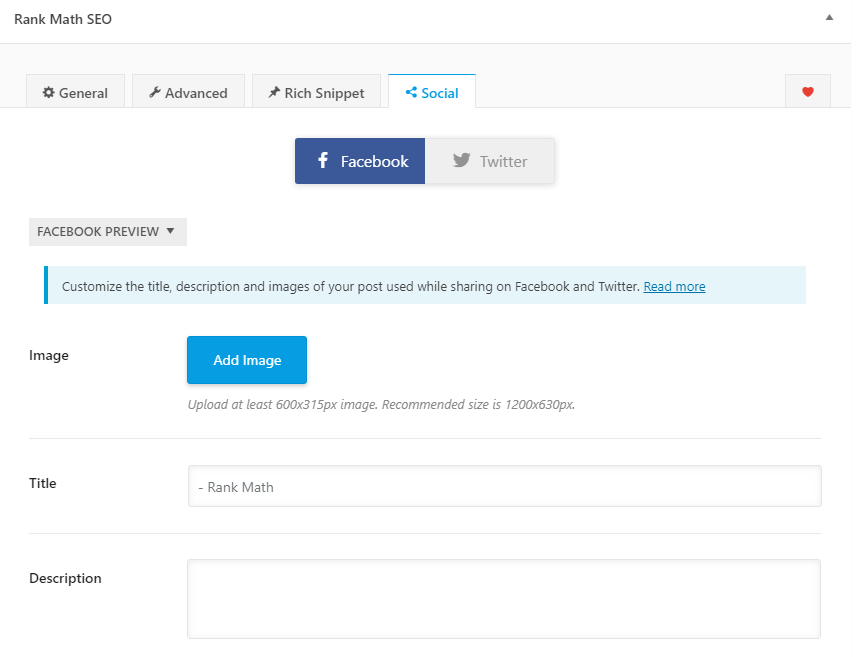
Click here to read the dedicated tutorial on configuring the Social Tab in Rank Math.
5 – The Bonus Section for Feedback
The last section is where we ask for your feedback. We’ve put many years of work in this plugin and released it for free to the public for a single reason—to help website owners like you get more traffic. All we ask in return is that you share your genuine feedback about the plugin by rating it and help spread the word.
The feedback tab is located to the far right, so as to not interfere with your regular blogging efforts. If you open it up, you will see a single option, which would be to rate Rank Math.
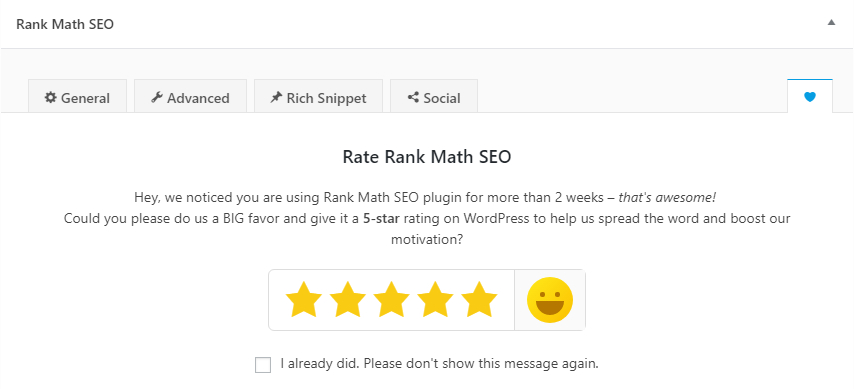
We encourage you to share your honest opinion and rate the plugin; although we do wish for a 5-star rating. Once you enter your rating, you will reach Rank Math’s page on WordPress.org where you can enter your rating and leave your review as well.
If you’ve already shared a review, then thank you, we appreciate it. Just click the checkbox that says “I already did. Please don’t show this message again”, and the feedback tab will disappear forever.
Conclusion
That covers an introduction to Rank Math’s meta box; the powerful toolset that will help you optimize your post. Keep in mind that this is just an overview, and the real settings are in the articles that cover the individual sections in detail. We recommend that you go through all of them, understand them, and learn how to configure them to your advantage. Doing so will improve your website’s traffic, attracting potential significantly. Here are the links to the individual sections for reference, again.
As always, if you have any trouble understanding anything we’ve said in this post, or in the detailed articles about the individual sections, you can always ask for help from our support staff. We offer premium support through our support forum and limited support through our Facebook Group—make sure to check them out for answers.









2 Comments
I read this post completely concerning the resemblance of newest and earlier technologies, it's amazing article.
ReplyDeleteHow To Use Rank Math Meta Box To Optimize Content In 3 Easy Steps >>>>> Download Now
ReplyDelete>>>>> Download Full
How To Use Rank Math Meta Box To Optimize Content In 3 Easy Steps >>>>> Download LINK
>>>>> Download Now
How To Use Rank Math Meta Box To Optimize Content In 3 Easy Steps >>>>> Download Full
>>>>> Download LINK 2U